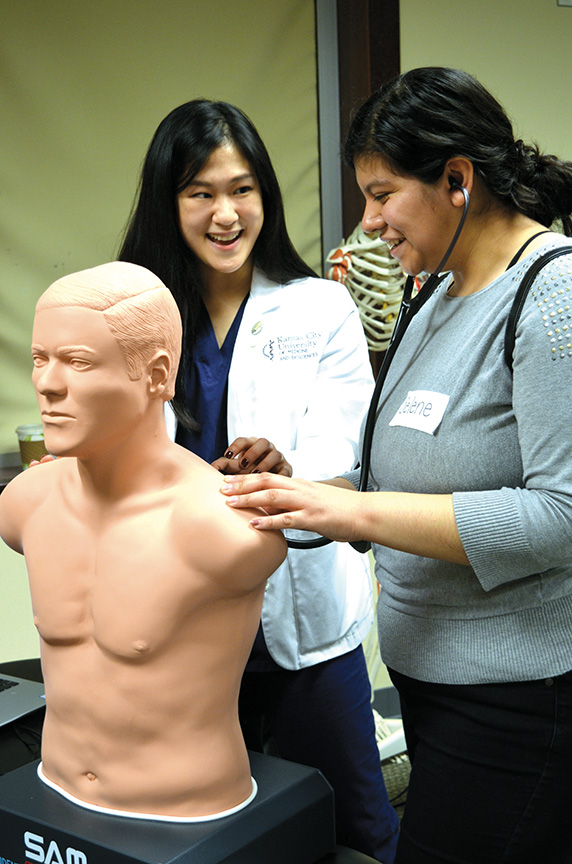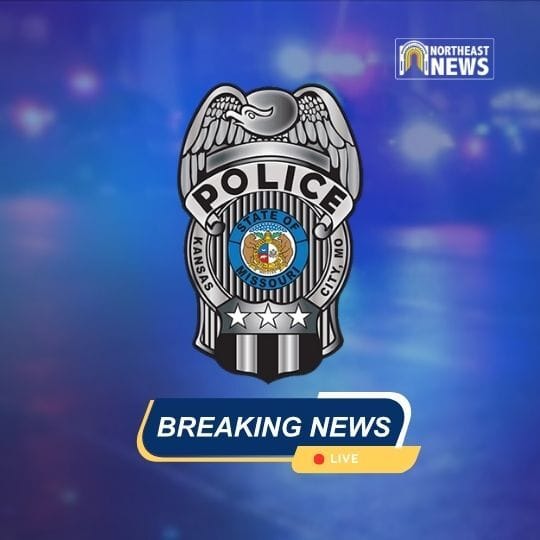KC high school students learn what it’s like to be a KCU med student for a day.

Elizabeth Orosco
Managing Editor
Nearly 80 Kansas City-area high school students converged at Kansas City University last week to learn what it’s like— and what it takes— to be a medical student.
The annual “Med Student for a Day” event offers high school students hands-on opportunities to work alongside first and second-year med students, faculty, and staff at KCU.
The event is hosted by current KCU med students as a way to introduce high-schoolers to the possibility of careers in the field of medicine.
The group of students rotated through four sessions: osteopathic manipulative medicine, bandage wrapping, introduction to anatomy, and clinical tools, where they were able to handle and use equipment like stethoscopes, otoscopes, and ophthalmoscopes.
In anatomy, they were able to handle donated lungs, livers, and other organs to see the effect and impact smoking or cancer can have on a person’s body.
This, most of the students said, was their favorite part of the event.
“It was cool, it was something different. It showed us what actually goes on in our bodies, what a diseased liver looks like, what a healthy liver looks like, and what we should look at if something goes wrong,” said Deaihra, a student at Southeast High School, who wants to be a nurse.
Au’lexi, another Southeast student, said her takeaway from the anatomy session was to “keep your body healthy and, if you can, donate your organs like they did, so it can be used in schools.”
Au’lexi hopes to one day be a nurse in the neonatal intensive care unit (NICU).
The three second-year medical students who put together this year’s Med Student for a Day event, Landon Riggs, Harsh Singh, and Katie Grabowski, said it was rewarding to see the level of participation and engagement of the students.
“For the osteopathic manipulative medicine session, I see kids pushing their heads to the sides to get a glimpse of what’s going on in the front and asking questions that we, as medical students and staff, have never heard before, like what they can do now to better understand anatomy and physiology,” said Riggs.
Miranda Hughbner, first year med-student volunteer, said the students she interacted with were open to discussion and fully engaged in learning how to use the clinical tools.
“A lot of them have really great questions,” she said. “We have covered how to do an exam, they’ve practiced with our mannequins, and they’ve been able to practice with each other. A lot of them have been very interested.”
The goal of the event is to, ultimately, get more students in the door who are interested in careers in the medical field, and to send them back out into the communities to serve.
“What we have seen in the wake of this [event] is that our young people are coming away with the sense that they can be more and there’s an opportunity to do more,” said Kevin Hubbard, a faculty member at KCU and third-generation alum. “It stimulates them to dream and allows them an opportunity to see that they could have a very bright future and they can contribute to their community. They can be trained in their community and come right back here to practice and take care of their neighbors. It’s an eye-opening experience for them.”
Singh echoed the aspect of service to the community, which he said was a large factor in why he considered attending KCU.
“Our motto is written on the sign outside our campus, ‘Improving the well-being of the communities we serve’ and I really took that to heart because anything we can do for the community is fantastic.”
Grabowski said for her, seeing light bulbs go off in a student’s mind for the first time is the most gratifying part of the day.
“I think the moment you see someone with that first ‘aha’ moment that tells them this is possible, that’s a really powerful thing.”
For Singh, the chance to touch one life would be worth the work.
“Even if I can spark one kid to follow a dream in a medical career, that’s all that matters, because that’s how I got started, by seeing people in med school and them showing me how they did it. Now, I get to pass that on.”
Hubbard recounted the history of his family’s long involvement in the medical field in Kansas City, having served the community since 1941, and said ultimately, his goal is to train his replacements in the medical field.
“I would really like for them to see something that provides inestimable value in this community that lets this community thrive and flourish. It’s also an opportunity to pay things forward well into the next century.
As the students continued to analyze organs, test stethoscopes, and get a clear vision of the path to med school, Grabowski said it comes down to opportunity and the belief that they can achieve this goal.
“I hope today that students find that seed that helps them spark some sort of curiosity and inspiration to go for what they really love,” she said.
“Everyone deserves a shot to do what they love. Today is an awesome day to see that spark.”
















